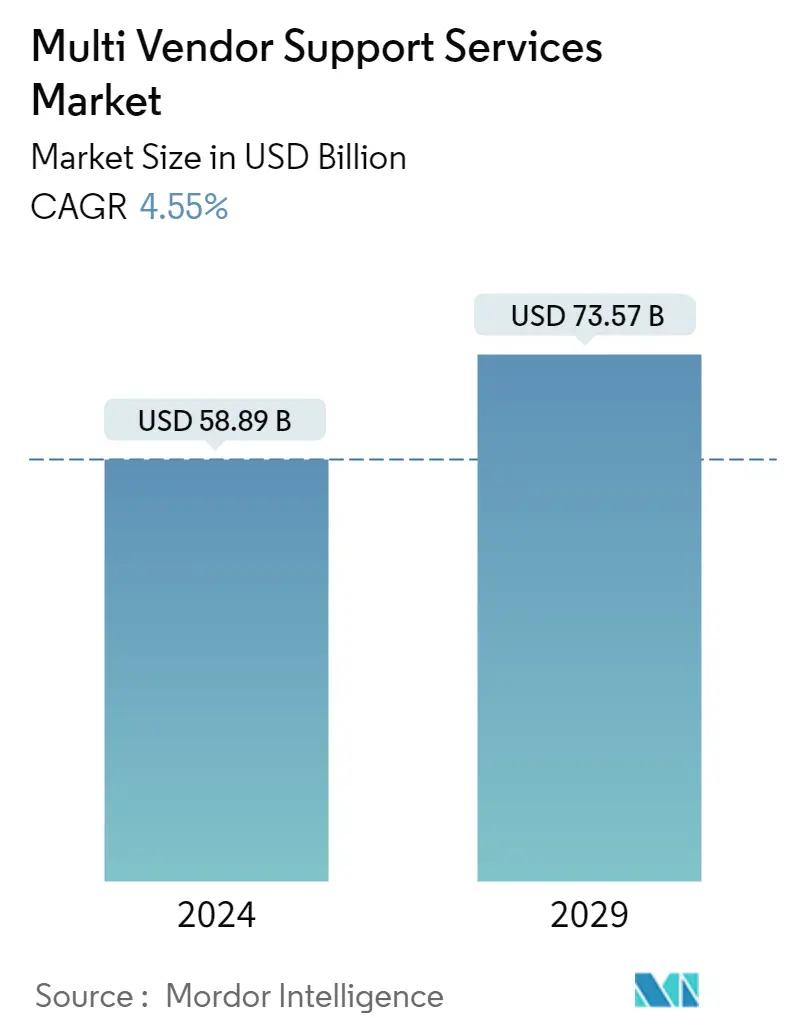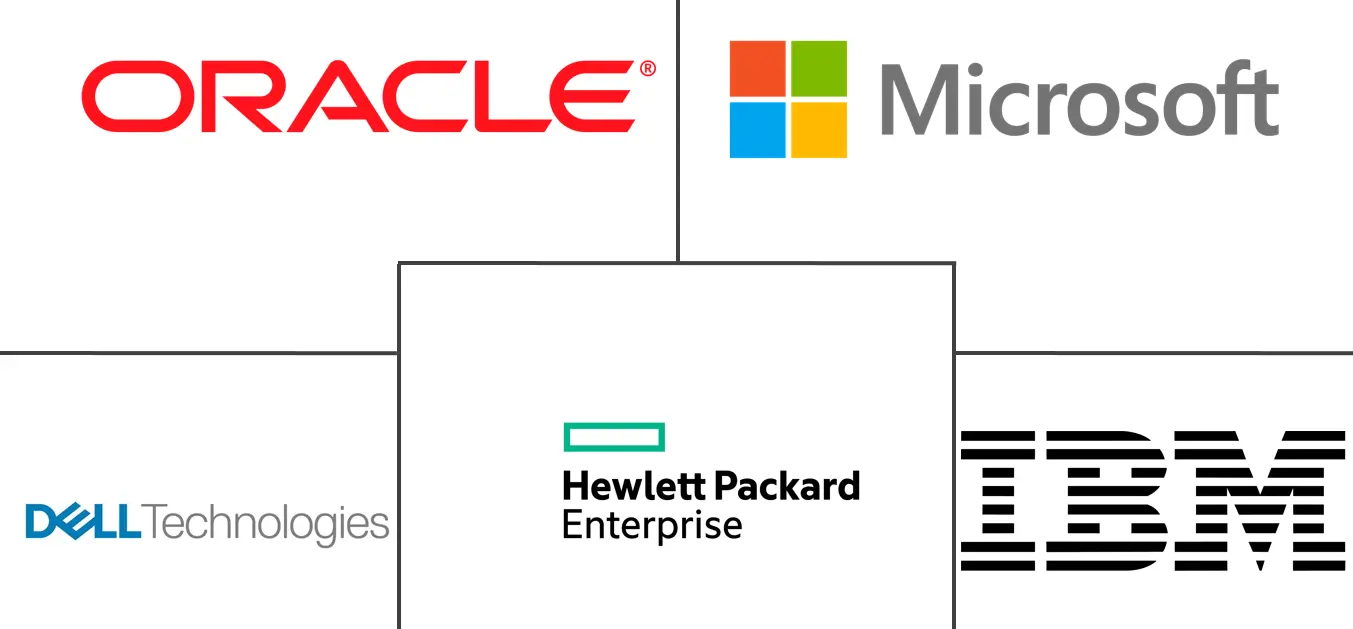Market Size of Multi Vendor Support Services Industry

| Study Period | 2019 - 2029 |
| Market Size (2024) | USD 58.89 Billion |
| Market Size (2029) | USD 73.57 Billion |
| CAGR (2024 - 2029) | 4.55 % |
| Fastest Growing Market | Asia Pacific |
| Largest Market | North America |
| Market Concentration | Medium |
Major Players
*Disclaimer: Major Players sorted in no particular order |
Multi-Vendor Support Services Market Analysis
The Multi Vendor Support Services Market size is estimated at USD 58.89 billion in 2024, and is expected to reach USD 73.57 billion by 2029, growing at a CAGR of 4.55% during the forecast period (2024-2029).
Multi-vendor support services can help any business to simplify IT management from multiple vendor contracts to a single vendor with expertise to maintain all the IT infrastructure. Therefore, multi-vendor support reduces downtime by streamlining problem identification and solving across the entire IT environment. There is a significant increase in the development and acceptance of advanced solutions among businesses. These multi-vendor support services help to decrease the risk associated with managing several IT solutions and services while improving smooth production or daily work. This is bolstering the demand for multi-vendor support services across the world.
- Unlike the last couple of IT infrastructure transition years, many businesses are shifting towards the third-party multi-vendor maintenance provider because of the severe budget constraints and reductions in the CAPEX. Enterprises seeking to do more while keeping it cost-efficient are interested in third-party maintenance to limit their solutions and service expenditures while retaining their conventional uptime and performance.
- The IT services for cloud, IoT platforms, containers, DevOps, and Big Data are expected to hold tremendous potential for the multi-vendor support service providers in the forecast period. Enterprises and government organizations worldwide are moving from conventional environments to placing more work-critical workloads and compute instances into the cloud.
- Further, owing to the rapidly increasing adoption of IoT, cloud, and Big data Analytics across multiple organizations as a significant part of their digital transformation strategy, the burden on the data centers is also increasing, leading to the market's growth. In the current scenario, data centers are more complex than ever, with thousands of components. Lifecycle maintenance in this difficult environment is essential, but it is also very challenging as IT players work to balance performance and cost. This is why lifecycle maintenance is an admin headache for today's enterprises. They have maintenance contracts with dozens of vendors, each with multiple types of equipment. With the increasing adoption of multi-vendor support services, the lifecycle maintenance of data centers becomes more manageable and cost-effective.
- The fast-paced and ever-changing challenges of supporting a multi-vendor support environment get exponentially difficult as an enterprise adds new technology to its IT infrastructure, updates levels of service, new support agreements, or updates warranties with each vendor. To solve these arising problems, total support management provided by technology providers like Dell Technologies is offering multi-vendor support services, which not only cut costs and increase productivity across an IT organization but also lower the burden on resources already managing too many daily admin tasks.
- At the time of the COVID-19 pandemic, remote working has surged worldwide. Multi-vendor support services providers are taking the opportunity to take advantage to solve enterprise problems to maintain a smooth working environment. For example, IBM Cloud solutions can help an enterprise to make a seamless transition to small business with flexible, secure cloud and digital services for virtualization, mobility, collaboration, and support. In the remote working condition, with the help of Cisco's in-depth knowledge base, IBM Corporation's intelligent network support delivers a proactive support model that helps the user to identify problems before they occur and affect enterprise operations.
Multi-Vendor Support Services Industry Segmentation
With the help of multi-vendor support services, businesses can consolidate their support services contracts for their mixed IT environment, ultimately saving significant money, effort, and time. The market scope of multi-vendor support services tracks the adoption of different support services used by several end-use industries such as IT & telecommunication, BFSI, healthcare, retail, energy & power, etc. The study also focuses on the impact of COVID-19 on the market landscape. In the report scope, the existing service provider landscape consists of significant market players.
The Multi-Vendor Support Services Market is Segmented by Service Type (Professional, Managed), Enterprise Size (Small & Medium Enterprises, Large Enterprises), End-user Verticals (IT & Telecommunication, BFSI, Healthcare, Energy & Power, Industrial Manufacturing), and Geography.
The market sizes and forecasts are provided in terms of value (USD million) for all the above segments.
| Service Type | |
| Professional | |
| Managed |
| Enterprise Size | |
| Small & Medium Enterprises | |
| Large Enterprises |
| End-user Verticals | |
| IT & Telecommunication | |
| BFSI | |
| Healthcare | |
| Energy & Power | |
| Industrial Manufacturing | |
| Others (Retail, Media & Entertainment, Travel & Tourism) |
| Geography | |
| North America | |
| Europe | |
| Asia Pacific | |
| Latin America | |
| Middle East and Africa |
Multi Vendor Support Services Market Size Summary
The multi-vendor support services market is poised for significant growth, driven by the increasing complexity of IT infrastructures and the need for cost-effective solutions. As businesses transition from traditional environments to cloud-based and digital transformation strategies, the demand for streamlined IT management solutions that consolidate multiple vendor contracts into a single, efficient service is rising. This shift is largely due to budget constraints and the need to maintain operational efficiency without compromising on performance. The adoption of advanced technologies such as IoT, cloud computing, and Big Data analytics is further propelling the market, as organizations seek to manage the growing burden on data centers and ensure seamless lifecycle maintenance. The market is characterized by a competitive landscape with numerous global and regional players focusing on strategic partnerships, research and development, and innovative solution offerings to capture a larger market share.
In North America, the presence of major technology providers and the rapid adoption of multi-cloud environments are key factors driving market expansion. The region's enterprises are increasingly outsourcing IT solutions to manage the complexities of modern IT infrastructures, which include a mix of legacy systems and new technologies. The healthcare sector's shift towards home healthcare and outpatient settings, along with the integration of smart devices and IoT, is also contributing to market growth. The telecom industry, facing intense competition, is leveraging multi-vendor support services to enhance service delivery and reduce costs. As organizations continue to embrace digital transformation, the market for multi-vendor support services is expected to grow, offering opportunities for managed service providers to deliver flexible, consumption-based pricing models and comprehensive support solutions.
Multi Vendor Support Services Market Size - Table of Contents
-
1. MARKET INSIGHTS
-
1.1 Market Overview
-
1.2 Industry Attractiveness - Porter's Five Forces Analysis
-
1.2.1 Threat of New Entrants
-
1.2.2 Bargaining Power of Buyers/Consumers
-
1.2.3 Bargaining Power of Suppliers
-
1.2.4 Threat of Substitute Products
-
1.2.5 Intensity of Competitive Rivalry
-
-
-
2. MARKET SEGMENTATION
-
2.1 Service Type
-
2.1.1 Professional
-
2.1.2 Managed
-
-
2.2 Enterprise Size
-
2.2.1 Small & Medium Enterprises
-
2.2.2 Large Enterprises
-
-
2.3 End-user Verticals
-
2.3.1 IT & Telecommunication
-
2.3.2 BFSI
-
2.3.3 Healthcare
-
2.3.4 Energy & Power
-
2.3.5 Industrial Manufacturing
-
2.3.6 Others (Retail, Media & Entertainment, Travel & Tourism)
-
-
2.4 Geography
-
2.4.1 North America
-
2.4.2 Europe
-
2.4.3 Asia Pacific
-
2.4.4 Latin America
-
2.4.5 Middle East and Africa
-
-
Multi Vendor Support Services Market Size FAQs
How big is the Multi Vendor Support Services Market?
The Multi Vendor Support Services Market size is expected to reach USD 58.89 billion in 2024 and grow at a CAGR of 4.55% to reach USD 73.57 billion by 2029.
What is the current Multi Vendor Support Services Market size?
In 2024, the Multi Vendor Support Services Market size is expected to reach USD 58.89 billion.

